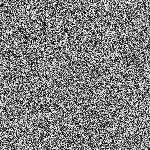지표면의 고도를 나타내는 데이터를 입력 받아 이미지로 표현하는 프로그램
문제 설명
지표면의 고도를 나타내는 데이터를 입력 받아 이미지로 표현하는 프로그램
입력 받은 데이터를 RGB 값으로 계산한 후 새로운 이미지 파일을 생성하여 이를 출력하는 프로그램
데이터 파일은 $m\times n$ 개의 숫자로 구성되어 있으며, 줄바꿈은 없다.
주어진 입력을 흑백 이미지로 출력하기 위해 입력된 데이터에서 최소값과 최대값을 찾고 shade of grey 계산
$shade of grey=\frac{elevation_{cur} - elevation_{min}}{elevation_{max} - elevation_{min}}\times 255$
계산한 값을 portable pixel map 형태로 저장. 흑백 이미지 이므로, 한 픽셀의 RGB 값은 동일
portable pixel map은 첫 번째 줄 문자열 P3, 두번째 줄에 width와 height, 세 번째 줄에 max color value, 나머지 줄에 RGB 값이 명시되어 있다.
P3
100 100
255
0 0 0 1 1 1 100 100 100 255 255 255
...
문제 풀이
#include <stdio.h>
#include <math.h>
#include <stdlib.h>
int readFile(FILE *file, int **matrix, int rows, int cols) {
for (int i = 0; i < rows; i++) {
for (int j = 0; j < cols; j++) {
if (fscanf(file, "%d", &matrix[i][j]) != 1) {
if (feof(file)) {
printf("Error: End of file reached prior to getting all the required data\n");
} else {
printf("Error: Error while reading file.\n");
}
return 1; // Error reading the file
}
}
}
if (feof(file)) {
printf("Error: End of file reached prior to getting all the required data\n");
return 1; // Error reading the file
}
return 0; // Successfully read the file
}
int findMax(int **matrix, int rows, int cols) {
int max = matrix[0][0];
for (int i = 0; i < rows; i++) {
for (int j = 0; j < cols; j++) {
if (matrix[i][j] > max) {
max = matrix[i][j];
}
}
}
return max;
}
int findMin(int **matrix, int rows, int cols) {
int min = matrix[0][0];
for (int i = 0; i < rows; i++) {
for (int j = 0; j < cols; j++) {
if (matrix[i][j] < min) {
min = matrix[i][j];
}
}
}
return min;
}
void loadGreyScale(int **matrix, int rows, int cols) {
int max = findMax(matrix, rows, cols);
int min = findMin(matrix, rows, cols);
for(int i=0;i<rows;++i){
for(int j=0;j<cols;++j){
matrix[i][j] = (int)round((float)(matrix[i][j] - min)*255 / (float)(max - min));
}
}
}
void saveFilePPM(char* originalFileName, int **matrix, int rows, int cols) {
char filename[100];
sprintf(filename,"%s.ppm", originalFileName);
FILE *file = fopen(filename, "w");
fprintf(file, "P3\n%d %d\n255\n", cols, rows);
for (int i = 0; i < rows; i++) {
for (int j = 0; j < cols; j++) {
fprintf(file, "%d %d %d ", matrix[i][j], matrix[i][j], matrix[i][j]);
}
fprintf(file, "\n");
}
fclose(file);
}
int main() {
int rows, cols;
char filename[100];
int **matrix;
FILE *file;
// Prompt user for the number of rows and columns
printf("Enter the number of rows: ");
scanf("%d", &rows);
printf("Enter the number of columns: ");
scanf("%d", &cols);
printf("Enter the filename: ");
scanf("%s", filename);
// Open the file for reading
file = fopen(filename, "r");
if (file == NULL) {
printf("Error opening file.\n");
return 1;
}
// Allocate memory for the matrix
matrix = (int **)malloc(rows * sizeof(int *));
for (int i = 0; i < rows; i++) {
matrix[i] = (int *)malloc(cols * sizeof(int));
}
readFile(file, matrix, rows, cols);
fclose(file);
loadGreyScale(matrix, rows, cols);
saveFilePPM(filename, matrix, rows, cols);
// Free allocated memory
for (int i = 0; i < rows; i++) {
free(matrix[i]);
}
free(matrix);
return 0;
}
평가
파일 생성
with open("map-input-100-100.dat", "w") as f:
for num in range(100, 0, -1): # 100부터 1까지 반복
f.write((str(num) + " ") * 100) # 각 숫자를 100번 반복하여 파일에 작성
import random
with open("map-input-150-150.dat", "w") as f:
for _ in range(22500): # 랜덤 생성
f.write(str(random.randint(1, 100)) + " ")
이미지 생성


Appendix
2차원 배열의 구조
int **matrix;
// Allocate memory for the matrix
matrix = (int **)malloc(rows * sizeof(int *));
for (int i = 0; i < rows; i++) {
matrix[i] = (int *)malloc(cols * sizeof(int));
}
// Free allocated memory
for (int i = 0; i < rows; i++) {
free(matrix[i]);
}
free(matrix);
rows는 3, cols는 4라고 하자
matrix = (int **)malloc(rows * sizeof(int *));
를 통해 matrix에는 길이 3의 할당되었고, matrix에는 해당 배열의 시작 주소를 가지게 된다. 즉,
matrix <---0x64
----------------------------
--------------------------
????????|????????|???????? 메모리에 저장된 값
--------------------------
0x64 0x72 0x80 메모리 주소
와 같이 구성된다.
for (int i = 0; i < rows; i++) {
matrix[i] = (int *)malloc(cols * sizeof(int));
}
이제 길이 4를 가지는 배열 3개를 할당하고, 할당된 주소를 이전에 할당한 메모리 0x64 - 0x80에 저장한다.
matrix <---0x64
----------------------------
--------------------------------
0x00000100|0x00000228|0x00000356 메모리에 저장된 값
--------------------------------
0x64 0x72 0x80 메모리 주소
------------------------
?????|?????|?????|????? 메모리에 저장된 값
------------------------
0x100 0x132 0x164 0x196 메모리 주소
------------------------
?????|?????|?????|????? 메모리에 저장된 값
------------------------
0x228 0x260 0x292 0x324 메모리 주소
------------------------
?????|?????|?????|????? 메모리에 저장된 값
------------------------
0x356 0x388 0x420 0x452 메모리 주소
즉 matrix는 0x64 라는 값을 가진다.
matrix(1)은 \(*(matrix + (1\times sizeof(int*)))=*(0x64+8)=*(0x72)\) 로서 0x228의 값을 가진다.
matrix(1)(2)은 \(*(matrix[1] + (2\times sizeof(int)))=*(0x228+64)=*(0x292)\) 로서, 해당 배열에 저장된 값을 출력한다.




댓글남기기